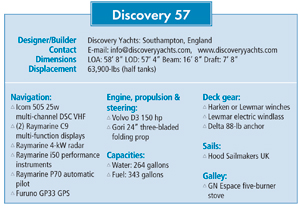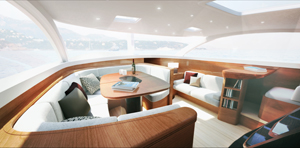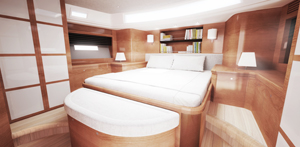Naval architect Ron Holland and his team have handled such vessels as the 1980s maxi racers Kialoa and Condor, the classic 32.4-meter ketch Kestrel, the first 60-meter Perini and a refit of the 75-meter sloop Mirabella V. So when Discovery Yachts of Southampton in the U.K. wanted a new boat to complement their Discovery 55, the Holland team, based in Kinsale, Ireland, and Vancouver B.C., was a solid choice to design the Discovery 57.
 |
|
The walk-in engine room is amidships and a second stateroom is forward up against a watertight bulkhead. |
Holland and crew handled the hull and rig while the new vessel’s interior design was done by the Ken Freivokh Design shop in Sarisbury Green near Discovery Yachts in Southampton.
The brief for the new 57 was simple enough: a comfortable, modern sailboat that can be handled by a voyaging couple. Though such a concept is easily stated, the devil is always in the details when it comes to making a boat that fulfills the original idea. The Discovery 57 benefits from the Holland team’s considerable experience and Freivokh’s design sense. The result is an intriguing marriage of verve and classic performance. A combination that should whet the appetite of any voyaging couple looking to move up to a more luxurious, yet capable boat.
The hull has a sleek waterline, fine entry and a beam that is carried well aft. This hull form is designed to provide both good performance and a comfortable motion in a seaway. The Discovery 57 has a high ballast ratio and a semi-balanced rudder and bulb keel that should contribute to easy handling, yet keep the boat stiff and steady even in challenging conditions.
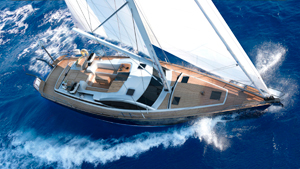 |
|
The center cockpit is comfortable and well protected from spray by coamings extending aft from the deckhouse. |
A-Ocean rating
The strong-cored hull meets CE regulations for category “A-Ocean.” Laid up in female molds in a climate-controlled facility, the hull is produced using the now standard practice of vacuum infusion, the major advantage of which is to produce a precise fiber-to-resin ratio. Befitting a high-quality lamination, the 57 uses vinylester resin, a stronger, if pricier choice over polyester resin. And it has two coats of isothalic gel coat, with non-pigmented gel coat below the waterline. The idea is to make a hull that is strong and impervious to the insidious osmosis of saltwater. The forward sections of the hull also employ belts of woven Kevlar for strength and a stiff structure.
Structurally, the hull is further toughened with large stringers that run the full length of the boat. And the 57 boasts watertight bulkheads aft of the chain locker, between the sail locker and the accommodation, and forward of the lazarette lockers. All plumbing and electrical services pass through watertight glands and each watertight area has dedicated bilge pumps.
Hung from this tough hull is a 21,000-pound external ballast keel. The keel shape is said to be the fruit of years of research and development by the Holland design team into the most effective keel outlines. Most of the appendage’s ballast weight is concentrated in an alloy bulb (lead with 3 percent antimony) that enhances the boat’s stability by virtue of a longer lever arm.
|
|
|
The master stateroom is tucked under the aft end of the cockpit. Taking advantage of the large windows, the main saloon has impressive views in port or at sea. |
Sited on the wide, uncluttered deck are some robust sailhandling tools. The 57 comes with a choice of Harken or Lewmar winches (Anderson winches are also an option). Four powerful, electric self-tailing winches handle genoa, main and staysail sheets and reefing lines. Mainsail clew outhaul and other control lines are led aft from the mast, through a set of organizers and Spinlock rope clutches to an electric winch. All sailhandling can be performed while still in the cockpit.
Even though the 57 has an 88-pound Delta anchor, you won’t see it on deck. The anchor self-stows in a special stemhead fitting. The hook is equipped with 330 feet of four-inch calibrated galvanized chain. A 24-volt vertical windlass is installed to haul that chain back up from the bottom. The winch can be operated from either foredeck or cockpit.
Speaking of cockpits, the driving station of the 57 manages to be wide open, yet still a safe space. The center cockpit arrangement is dominated by twin wheels with their pedestals, placed high for forward visibility.
The 82-foot anodized aluminum mast is set up with swept back spreaders, eliminating the need for running backstays and helping to keep the work load simple for the boat’s intended voyaging couple crew. Standard sails are by Hood Sailmakers UK, with the mainsail cut for electric in mast reefing with vertical battens. The main can set 861 square feet of sail and the genoa can spread 1,173 square feet.
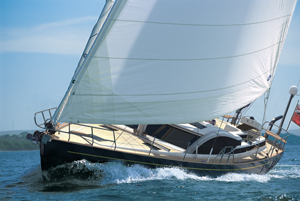 |
|
The sloop’s standard sails are from Hood UK and in addition to a roller furling genoa include an in-mast furled vertical-battened main. The stainless steel lifeline stanchions are 28-inches high for greater crew safety. |
Walk-in engine room
In addition to sails, the other source of propulsion is below in a walk-in engine room nearly amidships. The standard engine is the Volvo D3, a five-cylinder, turbo-charged unit that develops 150 hp at 3,300 rpm and turns a folding, three-bladed 24-inch Gori propeller. With fuel capacity of 343 gallons, the range of the 57 is impressive. The engine is fitted with two alternators (one 12 volt and one 24 volt), and the 57 also comes equipped with a Northern Lights low speed, heavy duty 4.5-kW 50-Hz (5-kW at 60 Hz) generator.
For added maneuverability when docking, the boat is equipped with a 10-hp, 24-volt MaxPower bow thruster.
In the electrical department, the 57 sports two DC buses, 12 volt and 24 volt. The 12-volt is for engine and generator start and each unit has a dedicated start battery. The 24-volt system is the main DC circuitry for the yacht. Included are heavy-duty, deep-cycle sealed gel batteries with a capacity of 480 amp hours at 24 volts and 960 amp hours at 12 volts. Rounding out the electrical gear is a 5-kW Victron Energy Quattro inverter charger. For AC electrical needs, the boat has an AC panel that feeds a 32-amp 230-volt system.
When it comes to accommodations, the Discovery 57 can claim semi-custom status. Each owner can arrange the interior to suit their needs. The standard layout has an owner’s stateroom aft with shower-equipped head. The galley occupies a length of the port side amidships and also acts as the passageway to the owner’s suite. The Discovery 57 has a raised deckhouse with seating for meals and socializing, and a nav station on the starboard side. The deckhouse, not really a pilothouse as there is no steering station, is wrapped on three sides with large windows, providing sweeping views.
Forward of the deckhouse is a stateroom with over and under berths, a second shower-equipped head and a forward stateroom.
If its owners feel the desire to roam, the Discovery 57 is a stylish, voyaging-capable sailboat that puts any spot on the world’s oceans within reach.
